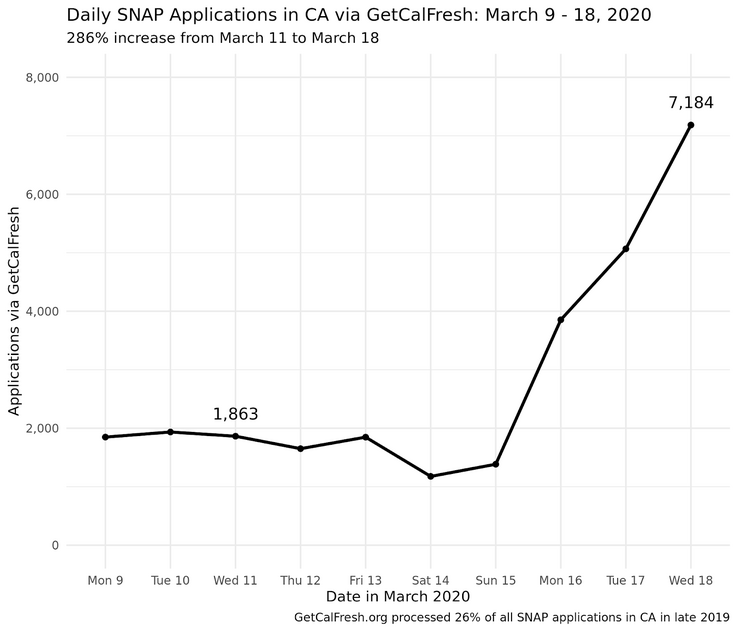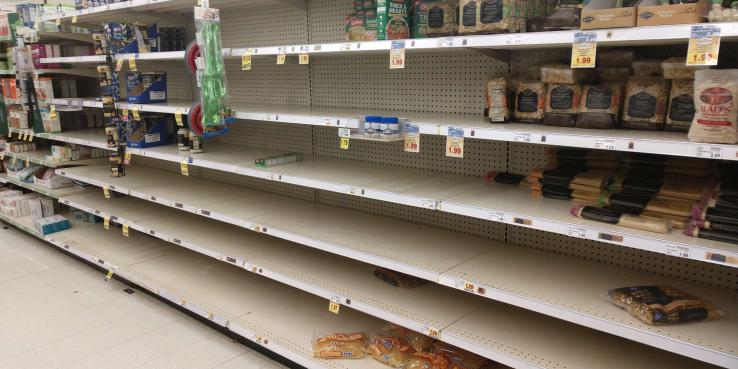This article also appears on NextCity.org.
As the coronavirus pandemic continues to spread, its immediate impact is most acutely felt in the loss of life, sickness and social distancing we are all witnessing. But only a couple of weeks into shelter-in-place orders here in the Bay Area and elsewhere across the country, the secondary impact on the economy is crashing down on us.
Huge sectors of the economy have ground to a halt, resulting in businesses shrinking dramatically — or closing up shop altogether — and laying off millions of people. In California alone, 1 million people filed for unemployment benefits in just two weeks. Looking ahead, projections on the number of people who might lose their jobs vary widely, but they are all grim and of historic proportions. Job losses are already leading record numbers of people to apply for CalFresh benefits (formerly known as food stamps) through state’s online application, GetCalFresh.

Amid this economic havoc, we all still need to eat. Which means we need a functioning food supply chain and people need to be able to access food.
To keep food flowing and avoid historic levels of hunger, policymakers at the local, state and federal level can, and should, take immediate steps. Some important measures have been taken: Congress has provided additional CalFresh benefits for many people and authorized funds to families whose kids are missing school meals, Governor Newsom has directed the national guard to assist food banks and local shelter-in-place orders have recognized food businesses as essential services. But more needs to be done.
After talking with policy experts and organizations working all across the Bay Area food system, we compiled a list of specific actions that agency heads and elected officials can take right now. This is by no means a comprehensive list — but it’s a start. We encourage policymakers to act quickly to dampen the impact of the virus on farms, at family’s dining room tables and everywhere in between.
City and County Policymakers Should:
Ensure county social services agencies are adequately staffed to process the surge of new applications.
In California, many social safety net programs like CalFresh and CalWorks (formerly known as welfare) are administered at the county level by social services agencies. These agencies are about to see an unprecedented flood of applicants. Without adequate staffing and streamlined processes, they will become a bottleneck that slows food assistance and cash aid, primarily funded by the federal government, from reaching people who need it. San Francisco's Human Services Agency recently adapted well to receive a surge of applications for CalFresh after a policy change that went into effect in 2019. Agencies in counties throughout the region will need to match or surpass that level of effort, with even less lead time.
Provide funding to expand programs that supplement government food assistance programs, like healthy food incentives, food vouchers, fruit and vegetable prescription programs, and food pantries.
CalFresh is a critical lifeline for people struggling to make ends meet. Healthy food incentive programs like Double Up Food Bucks, Market Match, ¡Más Fresco!, and Fresh Creds all provide matching dollars to people using CalFresh that help stretch food budgets further. But, benefits often aren’t enough to buy enough food. CalFresh also falls short because you can’t generally access benefits if you don’t have a U.S. citizen in your family. Because of this, local governments can’t rely on CalFresh to reach everyone who is food insecure. In addition, local governments should also direct funding to programs that don’t have the same eligibility requirements as CalFresh. Programs like Vouchers for Veggies (already operating in San Francisco and Los Angeles), for example, have already been working well and can scale more broadly. The local food banks operating in SPUR’s geography (San Francisco, Alameda and Santa Clara counties) are already operating on overdrive, and they too can use financial support to meet the need that is only going to grow, as can programs like Meals on Wheels.
Make it as easy as possible for parents to pick up “to go” meals for their kids at emergency food access sites.
Across the Bay Area school districts have rapidly moved from in-school meals to serving breakfast and lunch at community based pick-up locations. And just this past week, the USDA waived the rule stipulating that the school district cannot receive the traditional per-meal reimbursement unless a child is present while still encouraging local administrators to ensure “program integrity.” Stopping fraud is an important concern, but any process that local districts develop to identify eligible families should keep the barriers to accessing this school meals substitute as low as possible during this extraordinary time.
Lift restrictions on delivery routes during the crisis.
Keeping the food supply chain running smoothly during this time includes allowing food delivery trucks to move around at hours that may usually be restricted. Los Angeles, for example, in its emergency declaration, lifted its normal delivery curfew. As the California Grocers’ Association has highlighted, mayors and county executives should recognize that for the time being, regulations cannot assume a business-as-usual context.
Allow farmers’ markets to continue operating.
Farmer’s markets not only provide fresh food to thousands of families around the Bay Area, but they also provide the primary place where local farmers sell their product and make a living. Like with grocery stores, the Governor deemed farmers’ markets an “essential service” that can remain open during the statewide shelter-in-place order. Despite this, some local officials have shut down farmers markets. Local leaders should ensure that farmers’ markets are allowed to remain open and follow state guidance to reduce risk of exposure. The Community Alliance with Family Farmers can provide support on this issue.
State Policymakers Should:
Maximize flexibility so that as many people as possible can sign up for, and easily remain on, CalFresh.
Governor Newsom, through an executive order, and the state Department of Social Services, through a waiver the state received from USDA, have temporarily removed some of the requirements for documentation that often results in people losing CalFresh and other benefits. This is an important first step to help keep people connected to food assistance when county and state administrative capacity is strained.
Congress’s second package of relief legislation authorized USDA to waive a number of the onerous requirements people face when signing up for SNAP/CalFresh. California’s Department of Social Services should seek a waiver from the USDA to maximize the flexibility allowed and make CalFresh as easy to access as possible for the surge of new applicants who need food assistance quickly.
Enroll as many people as quickly as possible in “Pandemic EBT.”
Additionally, that same legislation also allows states to provide “Pandemic EBT,” which puts money for food on a debit card. The cards are provided to families with school-age children who qualify for free or reduced-priced meals and are no longer receiving meals at school. The state Department of Education and Department of Social Services should make this program as streamlined for families as possible by: identifying matches between the school systems’ databases and Department of Social Services’ databases, enrolling families quickly and focusing on opt-out mechanisms rather than more cumbersome opt-in options.
Expand other federally funded food assistance programs.
California Food Policy Advocates has a great set of additional recommendations that state agencies, including the Department of Social Services, Department of Education and Department of Public Health, can take to maximize the impact of federal food assistance programs such as WIC (Special Supplemental Nutrition Program for Women, Infants and Children) and the Child and Adult Care Food Program.
Classify grocery retail workers as emergency employees in order to extend additional benefits.
Grocery retailer workers are considered “essential” during the pandemic yet they do not have paid sick leave, putting both themselves and the customers they serve in danger. Extending additional benefits including paid sick leave and childcare allows these employees to take care of themselves and serve the community. The United Food and Commercial Workers are pursuing this intervention in California, following implementation in Michigan, Minnesota and Vermont.
Implement safety protocols for grocery retail, drug retail and food delivery employees.
Councilmembers in Los Angeles have called for safety protocols and worker protections at the local level. In addition, New York has outlined a number of best practices for grocery retail. The United Food and Commercial Workers are pushing for a number of these policy changes, which are examples of how California can support essential service employees.
Provide additional funding for emergency food providers.
The state of California has already recognized the importance of supporting the state’s food banks with state funds. While the most recent rescue package from Congress is likely to include more than $400 million for food banks nationwide, in California alone the need for funds could total one quarter of that amount. State lawmakers should work with the California Association of Food Banks to identify and fill any remaining funding gaps in the weeks and months to come.
Federal Policymakers Should:
Expand the SNAP Online Purchasing Pilot.
Currently, USDA allows people to use their SNAP benefits to buy groceries online for delivery in five pilot states. The USDA should both expand that pilot to as many states as possible, including California, and should also bring as many additional stores as possible into the program. Food delivery is key for those who are unable to leave the house, including high-risk populations during shelter in place. The California Department of Social Services has requested this intervention and notes that if the federal government approves online ordering, the department can implement it within two weeks.
Suspend new changes to SNAP, which would drastically reduce access to food.
Last year, USDA proposed three new rules that would, if implemented, drastically reduce SNAP access and benefits. At a time when Congress and the White House are rightly focused on increasing SNAP access, it does not make sense for USDA to move forward with these counterproductive rules.
Increase the base-level SNAP benefit by at least 15 percent.
As the Center on Budget and Policy Priorities has pointed out, SNAP benefits are already inadequate in many cases, and as we move into a period of high unemployment, that will be even more true. An across-the-board increase of SNAP benefits by 15 percent would help close the gap.
Weekly reports of job losses and business closure make clear that we are about to go through a period of economic hardship rivaled only by the Great Depression. Thankfully, since that time, policymakers have learned that there are steps local, state and federal government can take to blunt the blow of an economic shock. But those steps only work if they are taken. Given the magnitude of what we’re facing, immediate policy changes are needed in every aspect of our food system.
